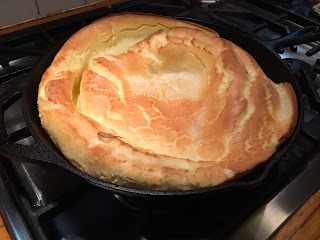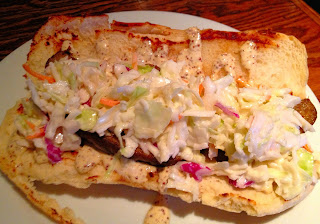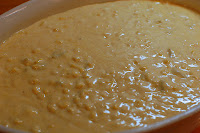Steaming is a wet cooking method that transfers heat to food via conduction, (i.e. from direct contact with the water vapor,) and convection, (i.e. from the upward motion of the water vapor.) Steaming is a highly effective method of transferring energy. Steaming doesn't leach away nutrients like immersion methods do since the food is not surrounded by roiling liquid. Steaming is ideal for more delicate meats and vegetables which would be damaged by the greater agitation and disruptive force of boiling or simmering water. Steaming and “health food” are practically synonymous making it the cooking method of choice for dieters everywhere since there is no fat employed whatsoever.
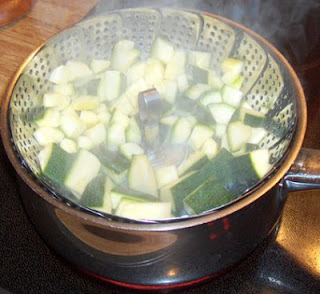
There are a number of equipment options for steaming. The first is the classic bamboo steamer, traditionally used to make a variety of Asian dishes. They can be stacked on top of each other thus allowing the simultaneous steaming of multiple items. Then, there is the traditional steaming pan which is basically a sauce pan with holes in the bottom that sits snugly on top of another saucepan which holds the steaming liquid. The most popular folding steamer insert, designed to conform to the diameter of any pot within its particular range. Our personal favorite is a silicone version of the steamer insert, but a colander set inside a larger pot of simmering water is an inexpensive, make-shift version.
Regardless of the vessel, the concept is that food placed in the upper section of a steamer is cooked by the heat and vapor of the liquid boiling in the lower section. A well-fitting lid, to keep the steam in, is important. Careful timing is essential as steamed food is tasteless if even slightly overcooked. Steaming is pretty straightforward. Bring the water to a gentle boil and place the food in the steamer and cover. Just make sure the food is not in direct contact with the liquid water. If you’re steaming something that takes an extended amount of time, you may need to add a little hot water during the process to compensate for evaporation.
Basic steaming is obviously performed with water, but you can use a flavored liquid and impart additional flavor to the food. Court-bouillon is a broth made from water, wine, vinegar and/or citrus juice, aromatics and herbs. Traditionally it is employed for poaching but you can use it as a steaming liquid as well. Moreover, when the item is done steaming you can utilize what’s left of the Court-bouillon as a sauce. For more intensity, boil some of it down for a richer sauce.
Potatoes are great candidates for steaming. The advantage of this method, especially with floury potatoes, is that none of the starch is lost in the water and there is no violent agitation to break up the potatoes. Cut the potatoes to a uniform shape and size and place in the top half of a steamer with the water below set to boil vigorously.
Most vegetables can be steamed in about five minutes. Do not over-steam or your green vegetables will start to lose their vibrant hues. Vegetables can be steamed in their own juice. Spinach, for example, may be put, wet from washing, into a covered pan and shaken over moderate heat for about 5 minutes. It will then be soft, bright green and much reduced. Press to extract excess moisture, add a tablespoon or 2 of butter and season. Green beans are another vegetable that lend themselves to steaming.
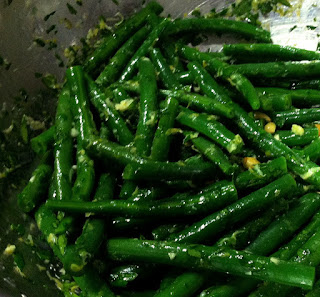 Steamed Green Beans Gremolata
Steamed Green Beans Gremolata- 1 lb. green beans, trimmed
- 1 tablespoon lemon zest
- ½ cup fresh parsley, minced
- 2 garlic cloves, minced
- ¼ cup extra virgin olive oil
- 1 teaspoon lemon juice
- ¼ teaspoon salt
Bring water to a boil and place steamer over water. Place the beans in the steamer basket and allow to steam for 8 minutes and test one of the beans for doneness. The beans should be until tender but still crisp and bright green. If they if they are not yet done, check again at 12 minutes. Remove beans from steamer and turn out into a mixing bowl.
Gremolata is an Italian herb condiment typically made of lemon zest, garlic, and parsley. Combine zest, parsley, garlic in a small bowl and slowly drizzle in olive oil stirring until well blended.
While the beans are still hot, toss them with two tablespoons of Gremolata and sprinkle with lemon juice. The lemon juice is added just before serving to keep the beans from turning brown (so, do not do this ahead of time). When ready to serve, place the beans on a serving plate and sprinkle with salt and garnish with a bit more chopped parsley. Serve hot or at room temperature.
These beans are delicious cold too. They can be kept covered in the fridge for up to 3 days. Toss them in a salad or just eat with your fingers.
 Acidulating liquid can impart a sour flavor to fruits, so a pinch of sugar is recommended to reduce the pucker. Since salt also slows browning, a pinch of salt added to soaking vegetables will add flavor and aid against discoloration. Additionally, vegetables (such as green beans) can be cooked in acidulated water which will help them to retain their color instead of graying or browning when they are cooked. This can make cooked vegetables look much more appetizing, and the faint hint of acid will add to the flavor.
Acidulating liquid can impart a sour flavor to fruits, so a pinch of sugar is recommended to reduce the pucker. Since salt also slows browning, a pinch of salt added to soaking vegetables will add flavor and aid against discoloration. Additionally, vegetables (such as green beans) can be cooked in acidulated water which will help them to retain their color instead of graying or browning when they are cooked. This can make cooked vegetables look much more appetizing, and the faint hint of acid will add to the flavor.
